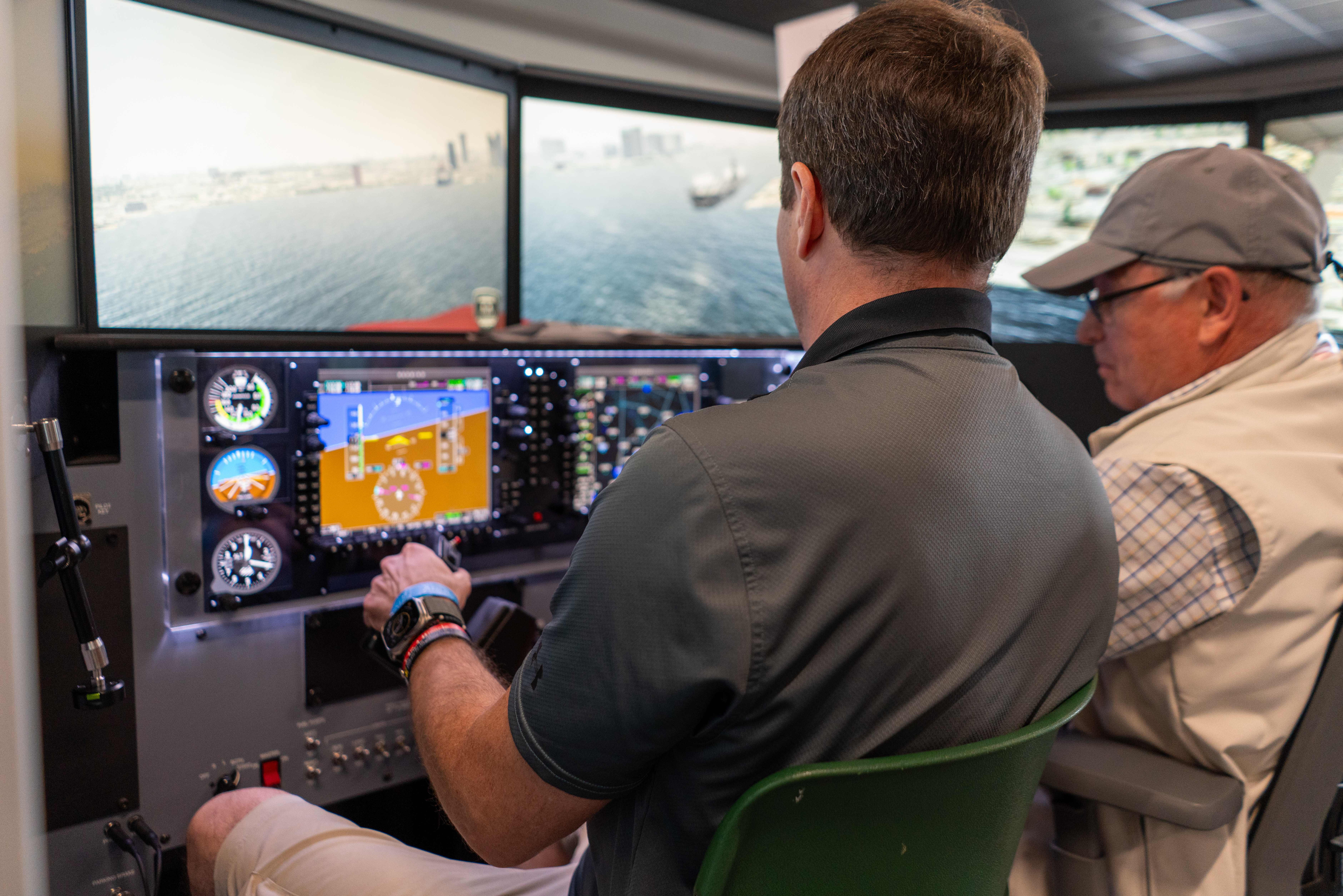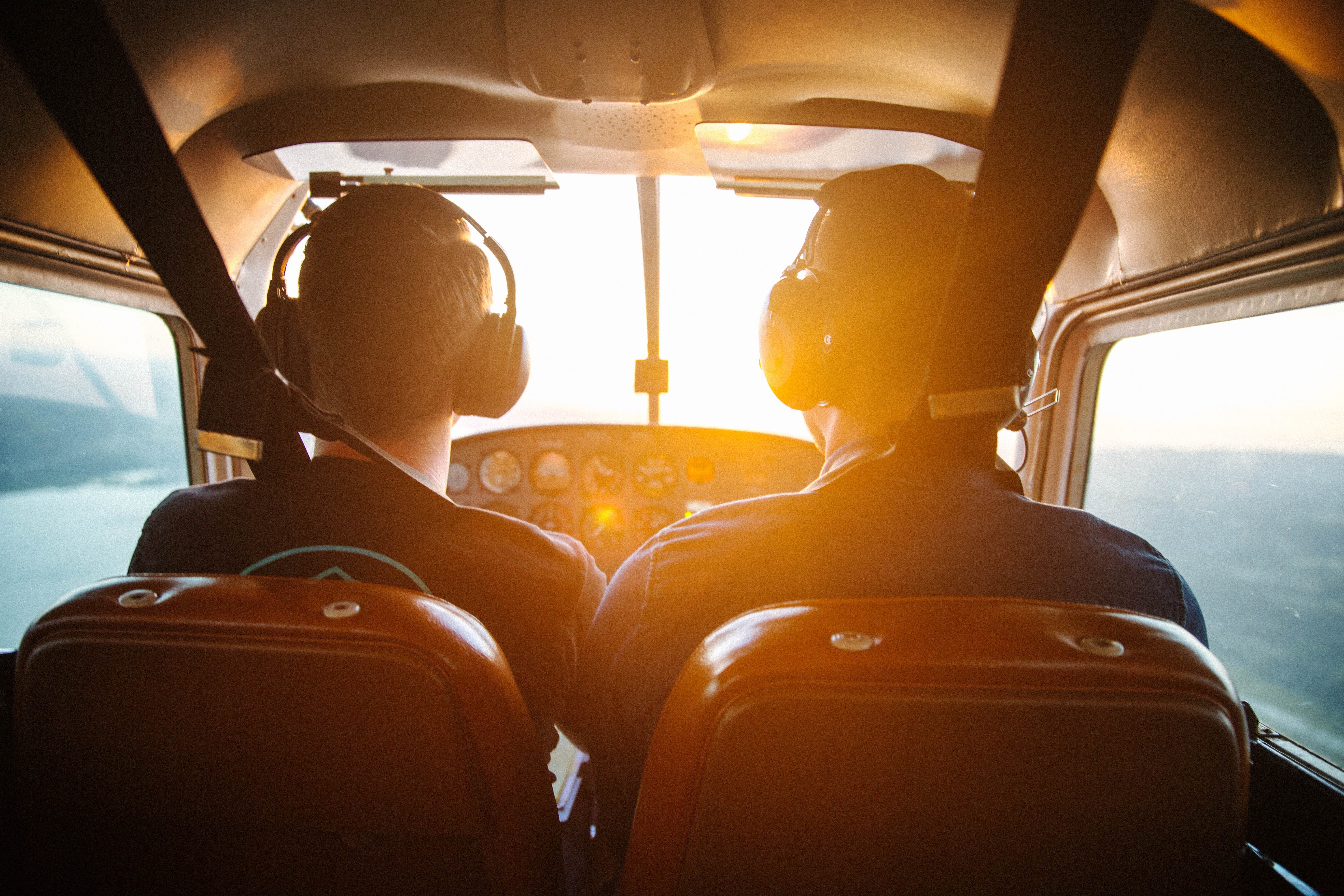How Top Flight Schools Use Full Motion Flight Simulators
Is a full-motion flight simulator worth the price tag? Every flight school and training center has its own opinion. A quality, full-motion training device can and should be an effective addition to any flight training program. However, you will only get a return on your investment if you use it well.
That's why organizations that have success with full-motion flight simulation generally use their devices for multiple purposes. Here are a few of the best uses to maximize your investment in a full-motion simulator.
Helping Private Pilot Students Learn to Fly
In primary flight training, the motion platform will help prepare your students for the real-world sensations of flying. They will shoot back in their seat at takeoff, feel the pull of the aircraft as they perform a steep turn, and notice the wheels touch down during a landing. Plus, the motion cues will always alert them when they are not in coordinated flight.
These features help immensely as your students pursue a private pilot license. Student pilots who learn flight skills in an aviation training device that provides accurate motion feedback transition to the real aircraft in less time because they know what it “feels like” to fly. They are less anxious in the cockpit, have better touch on the controls, and know why you need the right rudder in the climb.
Studies also show that motion simulators help students learn how to complete tasks amid external disturbances, such as wind shear or engine failure. Full-motion flight simulation is a great way to introduce realistic distractions to the flight training environment in a manner that's safe and manageable for the student.
Marketing and Sales Enablement
Whether the training benefits of a full-motion flight simulator justify the cost increase from a stationary simulator will be different for every flight school. The answer depends on the type of flight training you conduct, the revenue you generate from each training type, your budget, and other variables. However, there’s little debate over which simulator is the superior sales and marketing tool. Full-motion flight simulators help get students in the door.
We sometimes hear from flight training organizations that want to invest in a full-motion simulator simply because they are losing business to another flight school in town that has one. As a marketing tool, a full-motion flight simulator provides a competitive advantage in a couple of key ways.
Marketing Assets
Images and videos of a full-motion flight simulator are useful marketing assets for your organization. Prospective students expect that you will have a fleet of aircraft, but marketing a full-motion simulator separates you as an efficient, modern training organization.
This promotional video for CTI Professional Flight Training highlights the features of its flight simulator and explains how they improve the training experience for prospective students. CTI does a good job of abiding by a fundamental principle of video: "show, don't tell." The video shows the simulator yaw, pitch, and roll and takes the prospective student into the cockpit to see a flight training session in action. Even with informative narration, it still manages to let the training do the talking.
Thrust Flight Academy has a more candid approach to its promotional video, but it's still well-produced. The video is short and sweet, but it successfully demonstrates what the flight simulator can do and why the customer should want to use it. Featuring the flight academy's staff in the video is a nice touch. They come off as personable and knowledgeable, which is reassuring to prospective customers who want to book time in the simulator.
Flight Simulation Experiences
Full-motion flight simulators also allow you to provide a hands-on simulation experience before a discovery flight. During the simulator session, prospects can try their hand at any number of exciting scenarios. Mike McCurdy, Founder and President of Charleston-based CHS Flight School and IFR6, has all his prospective customers fly a simulated scenario at San Francisco Bay. In the scenario, the prospective customer circles Alcatraz and performs a pass under the Golden Gate Bridge.
McCurdy always pauses the scenario to talk to the prospective customer. He says that “you can see the lightbulb click and they’re going ‘oh, this is easy. We can hit pause? This is great.’”
The simulator ride isn’t difficult, and it takes less than five minutes. Yet, it allows prospects to do something cool and to have an immediate sense of accomplishment.
Tips for using a full-motion flight simulator as a marketing tool:
-List the simulator alongside your aircraft fleet on your website
-Shoot photos and videos of a full-motion flight in action
-Reach out to local media to earn coverage of your flight simulator training
-Hold an open house to introduce the community to your new flight simulator
-Post signage of your simulator outside your facility where pilots at the airport can see it
-Include a hands-on simulator experience with your prospective customers' discovery flights
Keeping Student Pilots Engaged
Your students should be excited that flight simulator training will allow them to reduce their costs and to learn in a safer, more controlled environment. In an FAA-approved flight simulator, they also can build flight time. That said, to prevent burnout, simulator training still needs to be stimulating and enjoyable.
The combination of full motion and scenario-based flight training gives your flight instructors powerful tools to keep student pilots engaged in the simulator. Scenario-based training is crucial in pushing students beyond their comfort zones, and motion will help immerse them without causing burnout. If you are looking for ways to invigorate your flight training program, emergency scenarios are a great way to engage student pilots in the simulator. California-based CFI Michael Phillips frequently uses these eight VFR emergencies to keep training interesting for his customers.

A full-motion flight simulator is also helpful when you are training maneuvers such as stalls, which can be intimidating or even scary for private pilot students. The motion is realistic enough to create an engaging and effective flight training environment. For instance, during a stall, cues from a full-motion flight simulator will allow your students to feel the buffet and the nose drop. However, the simulator won’t cause the type of stress or fear that leads some student pilots to drop out after stall recovery training.
Generating Revenue
If your flight school successfully creates an engaging flight simulation environment, then you have opportunities to generate revenue from a full-motion simulator as well. At a minimum, you can expect to increase your revenue by improving the following areas.
Customer Retention
The increased customer retention that a full-motion flight simulator can provide will make a notable impact on your revenue. This image shows an estimate of the revenue increases you could observe by using a full-motion simulator to retain just ten percent more of your students. In the given example, by reducing your dropout rate from 80% to 70% with a full-motion simulator, your revenue would increase by $84,000. That's if you are charging half the cost of your aircraft for flight simulator time (you potentially could charge more) and reducing your aircraft hours by 1.61% because of the simulator training. The spreadsheet also makes some assumptions about the total number of hours your students fly.
Regardless, this much is true: if your students practice all their maneuvers in the flight simulator before they move on to the airplane, they will be less overwhelmed, happier with their dollars spent, more inclined to finish their flight training, and your business will benefit. To learn more about how you can implement a flight simulator training strategy to achieve similar results, check out this webinar. The presenters break down the revenue spreadsheet at the 37-minute mark.
Operating Costs
In addition to helping you retain more students, full-motion flight simulators also have extremely low operating costs. The cost of electricity for a full-motion simulator is on par with that of a refrigerator—around 12 cents per kilowatt-hour. So, assuming you already have space for the simulator, service contract fees are your only notable, recurring cost of operating the simulator. With a Redbird aviation training device, those costs will be around ten dollars per operating hour—or less, depending on the service plan.
With a flight simulator, you are able to charge students a lot less than you would for your aircraft and still enjoy a higher profit margin. Plus, you will save on aircraft fuel and maintenance and make better use of your instructors' time.
New Revenue Opportunities
• Many flight schools with full-motion simulators will expand on the flight simulation experience they use in their sales pitches and offer it to the general public for a small cost. Here’s an example from FLT Academy, a flight training organization based in California and Utah.
• One of our customers in Allen, Texas, Safe Landings Aviation, uses a flight simulator to provide basic flight training to spouses of pilots. The "Right Seat Program" teaches frequent right-seat passengers the basics of controlling an airplane, landing it safely, and calling on the radio for help. The program costs $850 and includes three hours of flight simulator training and two hours in the aircraft.
• Full-motion flight simulators also allow you to create specialized courses for customers. You can offer a crosswind landing course regardless of the real-life weather conditions or a mountain flying course despite your geographic limitations.
Those are just a few examples. Suffice it to say, whether customers want to overcome a fear of flying, test the waters of flight training, or just do something fun for an afternoon, they will pay for flight simulator experiences. In addition to being a potentially reliable revenue stream, these experiences also can lead to your flight instructors signing up more private pilot students.
The Bottom Line
A full-motion flight simulator can be a great tool for your flight school. It provides an effective classroom for your flight instructors to introduce new scenarios to students and to let them fly in a safe and controlled environment.
Student engagement arguably is the biggest advantage a full-motion flight simulator has over its stationary counterpart. Motion adds a level of realism that will keep your private pilot students interested when they are not in the airplane. If a full-motion flight simulator engages your new and current students, then it will be a useful tool for sales, marketing, and customer retention.
Share this
You May Also Like
These Related Articles

How Pilot Training in a Flight Simulator Increases Flight School Revenue
-2.jpeg)
The Best Flight Simulator Controls for Every Pilot
